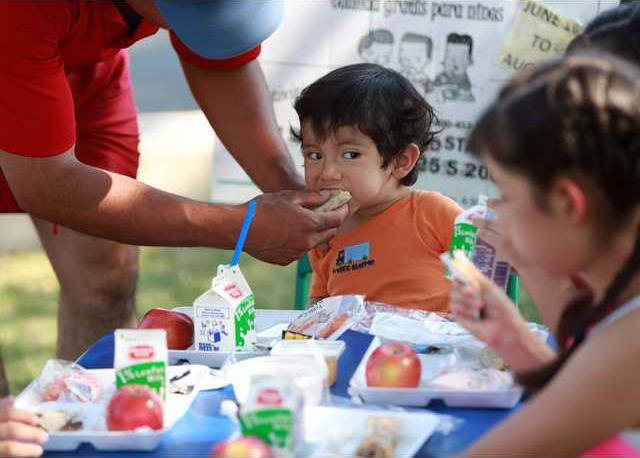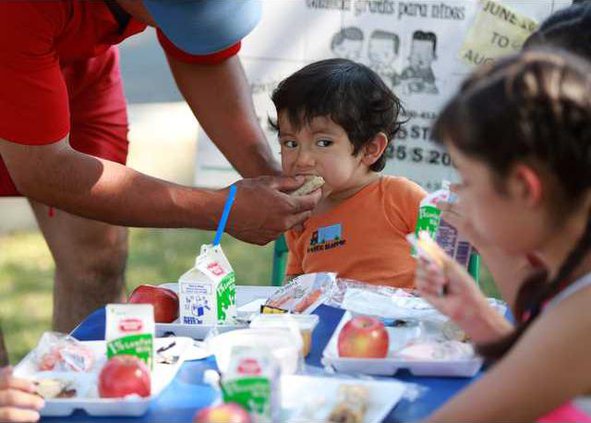Teen pregnancy rates are down dramatically and American children are more likely to reach adulthood than they were 25 years ago. But more of them are growing up impoverished.
The yearly Kids Count report, produced by the Annie E. Casey Foundation, provides a snapshot of what life is like for children in America, based on economic well-being, education, health and community measures. The 25th edition of the report was released Monday night.
A higher percentage of children live in poverty today than in 1990. The rate at first dropped from 18 percent but has since climbed again to 23 percent, said Laura Speer, the foundation's associate director over policy reform and advocacy. Some policies have helped economically fragile families, “but we live in a different economy now than we did in 1990,” she said. “What families face now to make ends meet is very different than it was, especially for those without a high level of education and without a highly skilled breadwinner in the household.”
Even in homes where two parents work, most families struggle economically, which Speer called “distressing.”
“It’s good we made as much progress as we did in lots of areas, but in how much American families are struggling, it has not gotten easier for most families in the country over that 25 years,” she said.
Today’s kids, standing on the brink of adulthood, must “achieve a whole lot more in terms of education and training entering the work force than their parents and certainly their grandparents did to survive and support their families," Speer predicted.
"Looking back a quarter century has been illuminating,” said Speer. “We do Kids Count because we believe the well-being of kids is the most important indicator for the well-being of the country. We found a lot of progress. We also saw there are still pretty dramatic inequities.”
By the numbers
Education and health are both bright spots, with improvement across both since 2005. The number of children not attending preschool dropped to 54 percent from 56 percent. The number of high school seniors not graduating is down to 19 percent from 27 percent, a big improvement. (The survey compared some of the 2012 numbers reported this year to those from 2005 in order to look at what was happening mid-decade, before the recession, said Kimberly Varner, speaking for the Casey foundation.)
But numbers can improve and still be distressing. The report said two-thirds of fourth graders are not proficient readers and a like number of 8th graders lag in math. Both were higher — above 70 percent — in 2005.
The number of low birth-weight babies is holding fairly steady at 8 percent; just 7 percent of children lack health insurance compared to 10 percent during the early part of the recession; and childhood deaths are 26 per 100,000 compared to 32 percent less than a decade ago. Only 6 percent of teens now abuse alcohol and drugs, a 25-percent improvement from 2005-2008.
When it comes to economic well-being, there’s nothing in the report to celebrate. Besides the fact that 23 percent of children live in poverty, more parents lack secure employment and struggle to afford adequate housing. Unchanged is the fact that one in 12 teens neither work nor go to school, a number the recession's end did not improve.
A higher percentage of kids also live in single-parent families and in high-poverty areas than in 2005. But far fewer high school students dropped out, with the figure falling to 19 percent now from 29 percent in the 2005/2006 school year.
The Centers for Disease Control and Prevention say kids are most likely to die from motor vehicle accidents, falls, burns and drowning. But the number of children dying from each has decreased significantly — a 19 percent decline for deaths from falls and a 45 percent decline for fires and burns, said Janet Brooks, child advocacy manager at Primary Chidlren’s Hospital in Salt Lake City. What has not improved is the suffocation rate of children from improper sleeping and bedding or poison-related deaths, mostly from inappropriate use of prescription and illegal drugs.
Some gains may surprise people.
Speer thinks most adults would say teens are more likely to become pregnant now than 25 years ago. They’d be wrong. Teen pregnancy is at a historic low and has been dropping for years.
“Hyperbole aside, it’s one of the nation’s real success stories,” said Bill Albert, spokesman for National Campaign to Prevent Teen and Unwanted Pregnancy. “More teens delay sex, teens have fewer sexual partners and those having sex are using contraceptives more consistently.” He said the teen abortion rate has fallen more dramatically than it has for older women.
Real people
Behind the numbers are programs and policies trying to make a difference for kids.
In many cities, programs work to fill the gap in nutrition for low-incomes families during the summertime. On July 18, Liz Guerrero supervised a summer food distribution in South Salt Lake, sponsored by Salt Lake Community Action Program/Head Start. The location is one of several where, rain or shine, staffers pitch an awning and provide a simple meal on weekday evenings. At this location, it’s not uncommon to feed 110 or more people, she said. The program targets low-income families, but they feed whoever shows up.
Patrick and Maria Perez brought a little table and chairs. In the shade of a tree, the family of eight ate simple burritos, apples and carrots. It is only the second time they’ve used the program, he said.
Lilia Llamas was there with her four kids, ages 3 to 14. She said the youngsters thrive in school and she is particularly grateful for teachers who help them figure things out if they struggle.
Many schools have afternoon tutoring programs to help children who struggle, but it takes funding to make that happen. Speer said one of the challenges programs face across a range of services for families is hanging onto what resources they have while figuring out what more is needed.
Families need adequate child care, high-quality preschools and other “base-level” supports to shore them up, she said, adding that it's not all about government programs.
Government programs are, however, part of the equation. Larry Joseph, director of research for Voices for Illinois Children, points to the federal earned income tax credit as "one of the nation's most effective tools for alleviating child poverty." It encourages and rewards work by supplementing wages of low-income working families, said Joseph.
Many states, including Illinois, have established their own version of the EITC. "At the end of 2011, after many years of advocacy by Voices and its coalition partners, the General Assembly enacted legislation that increased the state EITC from its original level — only 5 percent of the federal credit — to 7.5 percent in tax year 2012 and 10 percent in 2013," Joseph said. "In 2012, the state EITC benefited an estimated 1.2 million children. We currently support legislation that would help low-income families, improve tax fairness, and boost local economies by expanding the credit to 20 percent of the federal EITC."
State by state
The Kids Count report includes a snapshot of how each state compares to itself in the past and to other states today. Massachusetts, Vermont, Iowa, New Hampshire and Minnesota rank highest in terms of child well-being, while Arizona, Louisiana, Nevada, New Mexico and Mississippi come in last.
Iowa, Utah, Illinois, Indiana and Tennessee made the biggest improvements compared to last year's report. The biggest drops in ranking were in Wyoming, New Hampshire, New Jersey, Montana and Oklahoma.
State child advocacy programs note various challenges and victories. Jessica Mindnich, director of research for Children Now in California, said they see widening disparities, “like a pileup effect.” Some children start from so far behind they have trouble catching up. California, though, has more kids in preschool, reading on grade level and advancing in math than in the past. They have continued to improve access to health insurance and have their own health exchange, she said.
Asked what concrete change would make a difference, she points to preschool. “Preschool would be a really good first step. … Ensuring that all kids have a solid education is important if we want to compete globally. And that’s increasingly not a choice, but a necessity.”
The entire Kids Count report and state comparisons are online.
Email: lois@deseretnews.com, Twitter: Loisco





